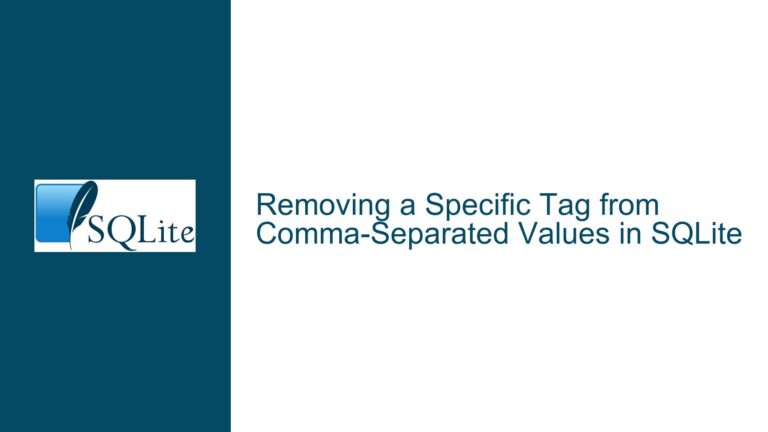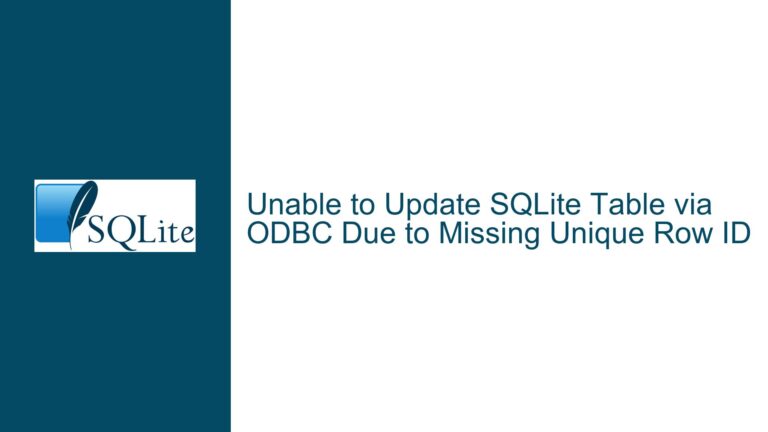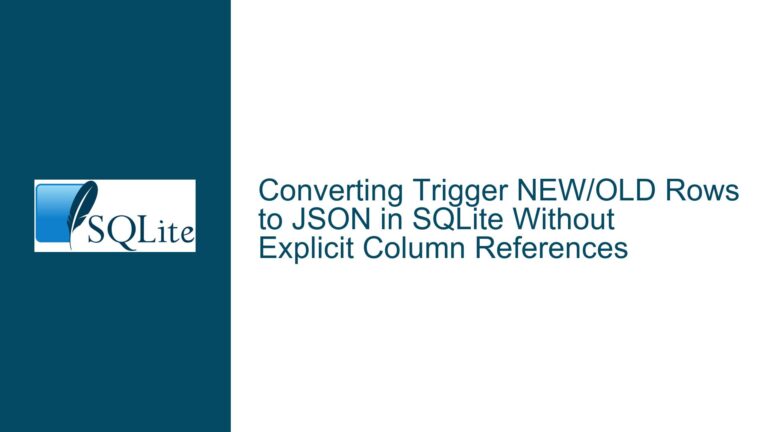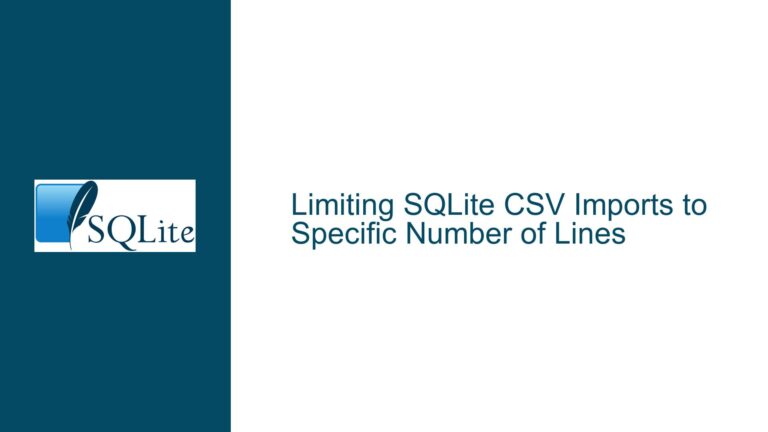CSV Import –skip Option Fails When Header Line Starts with Comma
Issue Overview: –skip Option Misinterprets Leading Commas in Skipped CSV Header
The core issue arises when using SQLite’s .import command with the --skip 1 option to bypass a CSV header line that begins with one or more commas. When the first line of the CSV file contains only commas (e.g., ,,,,,,,,,,,,,,,,,,,,,,,,,,,), the import process misinterprets the structure of subsequent data rows. This manifests in two ways:
- Unexpected Column Count Errors: SQLite may report discrepancies between the expected number of columns (based on the target table schema) and the actual number of columns parsed from the CSV. For example, a table with four columns may trigger an error stating "expected 4 columns but found 3" even if subsequent CSV lines contain valid data.
- Data Misalignment: Skipped header lines that start with commas cause the parser to misalign data fields. This results in NULL values or blank entries in columns where data should reside. For instance, a CSV line like
1,2,4,8might be parsed as1,2,4, andNULLinstead of populating all four columns correctly.
The anomaly is not strictly a violation of CSV formatting rules. The CSV standard allows header lines to start with commas, representing empty column names. However, SQLite’s CSV parser prior to the fix in commit 3aadbe17edc1efc7 treated leading commas in the skipped header line as a signal to reduce the expected column count. This behavior conflicts with the intended use of the --skip option, which should merely bypass the header without influencing schema inference.
Possible Causes: Parser Logic Conflicts with Header Skipping Mechanism
The root cause lies in how SQLite’s CSV import utility processes skipped lines and infers column counts. Below are the technical factors contributing to the issue:
Header Line Parsing During Skip:
The--skip Ndirective instructs SQLite to ignore the firstNlines of the CSV file. However, the parser still reads the skipped lines to infer the number of columns in the CSV. When the skipped line starts with a comma (e.g.,,,,), the parser interprets this as a header with zero named columns followed by empty fields. This creates a mismatch between the inferred column count (based on the skipped line) and the actual data rows.Incorrect Column Count Inference:
SQLite’s CSV parser uses the first line of the CSV (even when skipped) to determine the number of columns. A header line starting with commas is parsed as having fewer columns than intended. For example, a line,,,is interpreted as having zero valid columns, while subsequent data rows with four fields (e.g.,1,2,3,4) trigger a column count mismatch error.Interaction with Table Schema:
If the target table has a predefined schema (e.g.,CREATE TABLE t(a,b,c,d)), the import process expects the CSV data to align with these columns. The parser’s incorrect column inference from the skipped header line causes misalignment, forcing SQLite to fill missing columns withNULLor report errors.Edge Case Handling in CSV Parsing:
The parser’s logic for handling leading commas in header lines was not accounting for skipped lines. A header likeanykeyword,,,works correctly because the first field is non-empty, allowing the parser to infer the correct number of columns. Leading commas, however, were treated as a special case that reduced the effective column count.
Troubleshooting Steps, Solutions & Fixes: Correcting Column Inference and Aligning Data
1. Modify the CSV Header Line
Short-Term Fix: If you cannot update SQLite, edit the CSV header line to ensure it does not start with a comma. Add a placeholder keyword or identifier in the first field:
- Before:
,,,,,,,,,,,,,,,,,,,,,,,,,,, - After:
placeholder,,,,,,,,,,,,,,,,,,,,,,,,,,
This ensures the parser infers the correct number of columns from the header line.
Rationale: The presence of a non-empty first field in the header line forces the parser to count all subsequent commas as column separators. A header starting with placeholder, will be parsed as having the same number of columns as subsequent data rows.
2. Use an Updated SQLite Version
Apply the fix introduced in commit 3aadbe17edc1efc7 (available in SQLite versions after October 28, 2021). This update corrects the column inference logic for skipped header lines:
- Key Change: The parser now ignores the content of skipped lines entirely, relying solely on the target table’s schema or the first data row to determine column counts.
Verification Steps:
- Check your SQLite version:
sqlite3 --version - If using a version prior to the fix, download the latest source from SQLite’s official site or use a precompiled binary that includes the commit.
3. Adjust the .import Command Workflow
If modifying the CSV or updating SQLite is impractical, alter the import workflow:
Option A: Omit the --skip option and handle headers within the table schema.
- Step 1: Import the CSV without skipping the header:
.import -csv a.csv a - Step 2: Delete the header row after import:
DELETE FROM a WHERE x = 'x';
Option B: Use a temporary table to stage the data.
- Step 1: Import the CSV into a temporary table with a flexible schema:
CREATE TABLE temp_csv(data TEXT); .import -csv a.csv temp_csv - Step 2: Parse and insert data into the target table, skipping the header:
INSERT INTO a SELECT substr(data,1,instr(data,',')-1), ... FROM temp_csv WHERE data NOT LIKE '%,,,%';
4. Preprocess the CSV File
Use external tools to sanitize the CSV before importing:
- Example (Unix):
tail -n +2 a.csv | sed '1s/^,,,/placeholder,,,/' > cleaned.csv - Explanation:
tail -n +2removes the first line.sedadds a placeholder to the new first line if it starts with commas.
5. Validate Column Counts Explicitly
Use the --schema option to enforce column counts during import:
.import -csv --schema main.a a.csv a
This directs SQLite to use the target table’s schema for column count validation, bypassing inference from the CSV header.
Final Note: The issue stems from the parser’s reliance on skipped header lines for column inference—a behavior corrected in recent SQLite versions. Workarounds involve either modifying the CSV structure, updating SQLite, or adjusting the import workflow to decouple header skipping from column counting.






